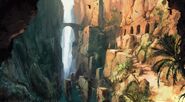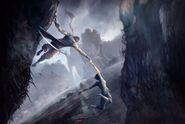
Prince of Persia (2008)
| Prince of Persia | |
|---|---|

| |
| Data | |
| Developer | Ubisoft Montreal |
| Publisher | Ubisoft |
| Platforms | PC, PS3, Xbox 360, Mobile, Mac OS X |
| Released | December 2, 2008 |
| Series | Prince of Persia |
| Previous game | Prince of Persia: Stories And Secrets |
| Next game | Prince of Persia: Epilogue |
The game is set in a variant of ancient Persia; the exact century is not revealed. In the game, the player assumes the role of the Prince, whose name, like all the other Prince of Persia games, is not revealed in the game. The Prince is accompanied by a girl named Elika, whom he met after a large sandstorm diverted him from his course and he ended up in a mysterious land. Players traverse many different environments using the Prince's acrobatic abilities to scale walls and even crawl on the ceilings. Throughout the journey, players combat various enemies as they attempt to cleanse the land of Ahriman's Corruption. The game's story line and setting borrow heavily from Zoroastrianism.
Gameplay
The gameplay in Prince of Persia retains a similar feel to the Sands of Time trilogy,
in the sense that the acrobatics, puzzle solving and combat elements
remain. However, the game is non-linear, and hence, the players are
given the opportunity to explore any part of the world at any time they
want to. The player fights enemies variously as they perform acrobatic
feats to get from one fertile ground to another, to heal them. In the
process of the game, the player has the opportunity to unlock various achievements for certain actions, as is common in most Xbox 360 games.
A new supporting character, Elika, has a large role in gameplay, in that she saves the Prince from death while in combat or exploring the world. The Prince cannot "die" in this game, as Elika will save him from any danger and bring him back to the last safe point of the game. For example, if the Prince slips and misses a jump, instead of falling to his death, Elika will grab him, and set him back on the last stable platform that the Prince stood on. Elika can also perform many combat moves, some in tandem with the Prince.

If the player uses a combat option other than the one prompted, they will be damaged. There are three stages of the Prince's health in combat; healthy, weakened, and grounded. When the Prince is in his healthy state, he is not yet damaged. When an enemy strikes the Prince, he goes into his weakened state. He is more vulnerable to being attacked in his weakened state, but it can sometimes take several strikes to make the Prince go into his grounded state.
When the Prince becomes grounded, the enemy makes a swift attempt to kill him. The player will be prompted into a quick-time action, in which they will have to push a button to subdue the enemy and get back up into their healthy state. If the player fails the quick-time event, pushing the wrong button, the enemy will attempt to kill the Prince. Elika, however, subdues the enemy as the Prince returns to his weakened state, but the enemy also regains a fraction of their health as well.
Acrobatics remain largely unchanged from the Sands of Time trilogy, except that Elika now provides acrobatic support. The Prince is capable of running on walls, sliding down walls, climbing walls, and jumping from wall-to-wall. The Prince utilizes his gauntlet as a tool to break the fall as he slides down a wall. Elika also plays a large role in acrobatics.
Elika boosts the Prince further than he can normally go, she saves him if he misses a jump, and she herself is very capable and agile. As the game progresses, the Prince can collect Light Seeds. The Light Seeds unlock certain abilities for Elika, which allow her to access various parts of the game world. The abilities activate certain plates, which, when boarded by Elika and the Prince, allow them to perform acrobatic feats that they couldn't otherwise, using magic.
Setting
The game is set in ancient Persia, in an undefined city-state where
Zoroastrianism is the dominant religion. At the center of the city-state
rests the temple imprisoning the god Ahriman, who was locked there by
the god Ormazd. Ormazd locked Ahriman there because Ahriman was trying
to conquer the land. At first, Ormazd stepped down, hoping Ahriman would
stop when no resistance was met, but was soon forced to take action due
to Ahriman conquering a majority of the countries and plaguing them
with Corruption. Ormazd managed to imprison Ahriman and his Corruption
inside the temple with the help of the Ahura. After this feat, Ormazd
departed the world to rest among the stars, humiliated that he lacked
the foresight to take action sooner.
Story
A new Prince of Persia, a wanderer, and "Prince" in nickname only,
stumbles into a forbidden land - a mythical city of beauty, dominated at
its center by a massive Tree of Life. The ancient evil god of darkness, Ahriman, was imprisoned within the tree after a cosmic struggle with his brother, Ormazd. When the Prince arrives, Elika's father, the Mourning King unleashes Ahriman in return for reviving Elika and all of his Corruption
is also unleashed upon the self-sustained world. The Prince takes up
arms against the corruption in an attempt to redeem himself and take
back his actions by driving the corruption away.
Prince of Persia begins as the Prince is caught in a fierce sandstorm while seeking his donkey Farah (a reference to the princess of the same name in the Sands of Time trilogy). The Prince, unable to see because of the sand, stumbles into a canyon and meets Elika, who requests that he follow her into a temple at the center of the kingdom. When they arrive inside the temple, Elika's father destroys the Tree of Life, which begins to free the god Ahriman. With the tree of life destroyed, Ahriman begins plaguing the land with Corruption. Elika explains that there are multiple fertile grounds found throughout the land that she has to reach and heal in order to again give the tree of life power and stop Ahriman from escaping the land.
As the Prince and Elika travel to and heal each fertile ground, Elika reveals her past: first her mother died, and then Elika did as well. Her father, the Mourning King, could not handle his grief, and made a deal with Ahriman. The Mourning King freed Ahriman, who resurrected Elika in return. She also teaches him about the history of the land. This includes telling him about the Corrupted, Ahrimans chosen few, who sold their souls for their desires. After the lands have been cleansed of Corruption, the duo returns to the temple to cleanse it as well; a necessary and final step in stopping Ahriman. Inside the temple, the Prince and Elika are confronted by the Mourning King. After being defeated by the duo, he jumps into the Corruption below. Ahriman then rises to oppose the duo, but is unable to defeat them before Elika heals the tree of life. After a long journey where he purifies the land, Elika gives up her life to seal Ahriman as it was Ahriman who gave her life back. The Prince, having fallen for Elika had to decide to either leave, or release Ahriman in order to revive Elika. The Prince cuts four trees scattered in the desert in front of the four respected areas he had recently purified, then returns to the Tree of Life and cuts it releasing Ahriman. He returns to Elika and walks off with the revived Elika in his arms. As he does, a black cloud rushes out from the temple bearing Ahriman's face. Ahriman then envelops the desert and covers the couple. However the last achievement/trophy received states "To Be Continued", as well as from interviews it has been stated this is the beginning of a new Saga in the Prince of Persia storyline.
Characters
- Prince - The main protagonist of the story, a thief, a vagabond, a wanderer in search of his lost donkey and stuck in a new adventure together with Elika.
- Elika - The last princess of the Ahura, an ancient race from the strange lands in Persia the Prince finds himself in. She has the power of Light.
- Ahriman - The God of Darkness, imprisoned by the Ahuras, he is released and now plagues the Kingdom of the Ahuras and spreads the Darkness.
- The Mourning King - Elika's father, the last king of the Ahuras, who frees Ahriman to revive his daughter from death. He becomes one of Ahriman's minions in the end.
- The Hunter - One of Ahriman's great generals who was once a prince.
- The Alchemist - Another of Ahriman's great generals who was once an Ahura
- The Concubine - Ahriman's only female general who was once a seductive politician.
- The Warrior - Ahriman's general who was once a king.
- Ormazd - (Mentioned) the brother of Ahriman and the God of Light.
Development Edit
Edit
Proof of development for the game was found when, on September 21,
2006 a leaked RAR file contained concept images, although no comment was
made by Ubisoft. Also, on January 23, 2008, some screenshots from the
game were leaked onto the internet, and again Ubisoft made no comments.
On April 1, 2008, Ubisoft registered the domain
"princeofpersiaprodigy.com", making many fans speculate the name of the
game.
In May, Ubisoft confirmed that the general staples of the gameplay are to remain intact, including platforming, and combat. Although the game focuses more on one-on-one combat, similar to the original Prince of Persia trilogy, rather than fighting almost dozens of enemies, like in the Sands of Time trilogy.
On May 8, 2008, Ubisoft released an official video of a concept artist designing the Prince character for the game. The "speed art" video shows a full-bodied new prince to be created on Photoshop. There was another concept art video released on May 22, detailing a female character Elika. It is also a fast-forward of a concept art drawing.
Reception
The game was well received by most critics, scoring an 81%, 85%, and
82% on Metacritic for the Xbox 360, PlayStation 3, and PC, respectively.[1][2][3]
IGN writer Hilary Goldstein praised the game for its simple but visually
spectacular acrobatics and combat, but noted that one must "embrace the
change [to the series]" in order to "fall in love [with it]".[4]
Goldstein also praised Elika, the secondary character of the game, as a
useful sidekick during gameplay and also as a likeable character with a
great relationship with the Prince.[4]
GameSpot's Kevin VanOrd shared a similar opinion and in addition praised its excellent artistic design.[5]
However, many criticized the game for being too easy or
"consumer-friendly", regarding the simple platforming and combat
segments.[4][6][5]
Eurogamer described it as a "poor game" with "excessive repetition" but
nonetheless with "fantastic technology and interesting mechanics".[6] 1UP.com criticized the trial-and-error nature of the platforming gameplay.[7]
Many comparisons have been drawn to other video games in terms of artistic design and gameplay. Examples include Mirror's Edge[7] and Ubisoft's own Assassin's Creed with unique platforming and timing-based combat.[6][5] The vast open-world environment with intense boss fights have been compared to Ico and Shadow of the Colossus,[7] and the watercolor looks to Ōkami.[8]
DLC
- Main article: Prince of Persia: Epilogue'
Trivia
- There is an achievement/trophy 'Precious Time'. It takes over a minute and one second to do it on Xbox and it takes 58 seconds to do it on the PlayStation.


















































No comments:
Post a Comment